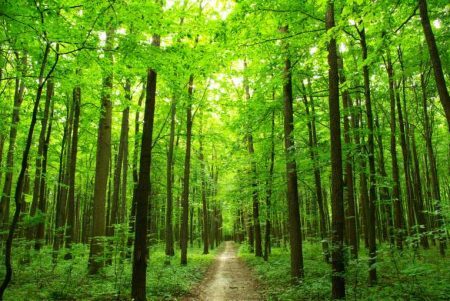November 22, 2018 – In the reports of a study on terrestrial nitrogen appearing in the October 22, 2018 issues of Nature – Ecology & Evolution, researchers from University of Maryland, Indiana University, Purdue, Ghent, Cincinnati, Bordeaux, the Chinese Academy of Sciences, and other contributors from 12 countries’ academic and research institutes, have come to an unsettling conclusion. The ability of natural forests to act as a carbon sink to remove carbon dioxide (CO2) from the atmosphere is diminishing because of limitations on nitrogen. Studying 43,000 leaf samples collected from hundreds of tree species from 1980 to 2017 suggests that the natural ability of forests to sequester carbon is declining because of increases in nitrogen absorption by forests from soils.
How Forests Sequester Carbon
Why is this happening? To understand the answer we need to look at how forests sequester carbon and how much is sequestered globally annually.
Trees are living carbon. As a tree grows it absorbs carbon from carbon dioxide (CO2) in the air. It takes in carbon through its root systems. This continuous uptake continues until the tree stops growing, matures, and then begins to die. A dying tree releases carbon through decomposition. Even in death, however, a tree retains much of the carbon absorbed during its lifetime. The wood debris, leaf litter, and root systems add carbon to the forest top soil, that is, until all of these tree remainders completely decompose. At that point, all the carbon that was once a tree goes back into the atmosphere.
An old growth forest represents an optimal carbon sink. These trees like the magnificent forests of Western Canada represent nature’s best land-based carbon capture and storage mechanism. But clear-cutting of these forests for wood, pulp and paper, and other forest products, turns such mature forests into net carbon contributors rather than sinks. And wildfires such as the outbreaks that devastated British Columbia and California last summer, and the latter throughout the last few weeks, not only destroy homes and kill people and animals, they also release carbon in large volumes and at very rapid rates, further contributing to carbon in the atmosphere.
When we make furniture from harvested trees, half of the wood’s dry weight is carbon. That’s why a good way to sequester carbon is to build with wood whether it’s housing, buildings or furniture. This type of industrial activity serves to be a long-term carbon sink.
Without looking at the issue of nitrogen absorption by trees, the general consensus on the current state of the world’s forests as carbon sinks is that their present-day contribution to sequestration amounts to 2.4 Gigatons annually. The number stated here is based on the current distribution of forests across the planet. When compared to the estimated 10 Gigatons of carbon emissions humans add to the atmosphere each year, you can see that forests today sequester less than 25% of the greenhouse gases our modern industrial societies produce.
Climate change skeptics argue that an atmosphere with more carbon in it will make for a greener planet which means more trees and therefore less atmospheric carbon. In their minds, the temporary imbalance will work its way through Earth’s natural systems leading to more vigorous plant growth and our green friends bailing us out of the current excess of atmospheric carbon. It would be nice to believe in that fairy tale if it were only true. But it’s not.
What’s Nitrogen Got to Do With Carbon Sinks?
Nitrogen makes up more than 78% of the gas in our atmosphere. It can be found in amino and nucleic acids. So we are made up partly of nitrogen. Some bacteria absorb nitrogen creating an organic form of the element. The process of bacterial interaction with nitrogen fixes it into the soil and our oceans. When we and other organisms die the nitrogen contained in us returns to the soil or ocean and is then taken up by bacteria with some of it returning to the atmosphere but the bulk of it being retained in the ground and water.
Photosynthesis requires nitrogen for it to work. Increase the volume of plants doing photosynthesis and nitrogen demand goes up. In a previous posting on this website I described how elevated atmospheric CO2 levels are causing the expansion of the planet’s tropical zones poleward. This happening because of CO2 which is causing mean temperatures to rise. That means growing seasons are getting longer which means trees and other plants are drawing on the fixed nitrogen stores found in soils. The rate of plant photosynthesis demand, therefore, is depleting nitrogen stores. In such circumstances, we can predict that forest growth will be self-limiting as nitrogen stores get depleted further. And that means that the forests of the world will hit a carbon sequestration limit even if they naturally keep expanding or we choose to plant trees en masse.
In the paper cited above the authors conclude that “the proposed consequences of elevated atmospheric carbon dioxide and longer growing seasons…..will limit future terrestrial carbon uptake.” The consequences for ecosystems dependant on forests for survival will mean greater stress on other forest life from the smallest bacteria to insects, large herbivores and their dependent carnivores. Of course, we humans could begin fertilizing the forests just as we do in agriculture to assist crop growth through applications of nitrogen-based supplements. Doing this will yield additional consequences as we add more nitrogen to forest soils leading to more nitrogen getting into watersheds and ultimately leading to lakes and oceans developing nitrogen-induced algae blooms.
So we now know the availability of soil-based nitrogen is a forest delimiter. And climate change skeptics who see more CO2 as good for the planet are clearly wrong because instead of increasing forest and plant growth, the presence of more of this greenhouse gas will eventually damage existing and future forest ecosystems.
















